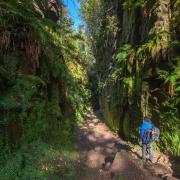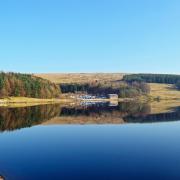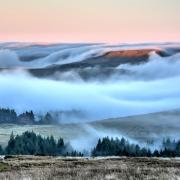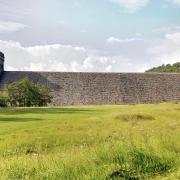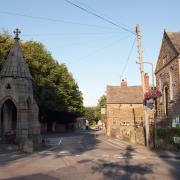By Mike Smith
The spectacular above-ground attractions of Derbyshire are matched by the county’s subterranean wonders.
Some of these hidden marvels are the legacy of millions of years of chemical action between rain water which has seeped through the porous surface of the White Peak and the limestone below, creating cathedral-like underground spaces where stalagmites rise from the ground like soaring nave columns and stalactites hang from the ceiling like pendant vaults.
The county’s natural caves are complemented by several man-made caverns. Excavated in the first instance to extract lead and fluorspar, they were converted into show caves by enterprising miners when supplies of the minerals ran out or their extraction was no longer profitable.
THE SHOW CAVES OF CASTLETON

The village of Castleton, wonderfully positioned at the head of the Hope Valley, beneath the lofty Norman keep of Peveril Castle, is the location for four show caves. One of these is entirely natural, but the other three are man-made.
The approach to Castleton’s only natural cave is framed by two gigantic pillars of limestone, forming the largest natural cave entrance in the country.
Rope-makers once lived and worked in this awesome space, taking advantage of the dry conditions and even temperatures. Famous past visitors to the cave system, which stretches far into the hillside beneath Peveril Castle, include Daniel Defoe, Lord Byron and Queen Victoria, whose blushes were spared on her visit in 1842 when the traditional name of the Devil’s Arse was changed to Peak Cavern. More recently, the original label has been revived.
Included by Thomas Hobbes in his ‘Seven Wonders of the Peak’, published in the 17th century, the cavern remains a very popular tourist attraction, not least during the Christmas season, when a series of carol concerts take advantage of the fine acoustics in the cavern, and on those occasions when one of the underground rooms is transformed into a pop-up cinema.
The steep hillside immediately beyond Peak Cavern contains the main source in the world of Blue John stone, a form of fluorspar which reveals zig-zag bands of blue and gold when cut and polished.
It has been suggested that the stone, which is used to make ornaments and jewellery, acquired its name because it was first cut and polished in France, where it was christened bleu-jaune.
The Blue John Cavern, which is home to eight of the 14 known varieties of Blue John stone, includes a space known as the Waterfall Cavern, where stalagmite formations resemble a frozen waterfall, and a cave called Lord Mulgrave’s Dining Room, where his lordship is said to have entertained his miners to dinner.
The neighbouring Treak Cliff Cavern includes the ‘Old Series’ of caves containing rocks of Blue John, which were discovered during blasting in the 18th century, and the ‘New Series’, created when a new round of blasting carried out in the 1920s exposed a spectacular display of stalactites, stalagmites and flowstone.
The Café on the Cliff, which is open to passing ramblers as well as visitors to Treak Cliff Cavern, has outside seating with beautiful views over the Hope Valley.
Speedwell Cavern, located at the foot of Winnats Pass, the steep road that links the Hope Valley with the High Peak, is a former lead mine, which opened in 1771, but closed as a mining operation after just 20 unprofitable years.
Visitors to the cavern are treated to a unique experience. After descending 105 steps from an almost hidden cave entrance to a landing stage, they board a boat that takes them on a thrilling 450-metre underground canal journey through a narrow tunnel. Eventually, the passageway opens out into a huge cavern containing the so-called Bottomless Pit.
BUXTON’S POOLE’S CAVERN

The extensive network of underground passageways known as Poole’s Cavern was formed 2 million years ago beneath Grin Low, a hillside located to the south of Buxton and now part of the Buxton Country Park.
Said to have been the hideout of an outlaw called John Poole in the 15th century, the cave system was visited by Mary Queen of Scots when she came to the Derbyshire spa in 1582 to take the town’s health-giving spring waters.
Although the limestone cavern was formed naturally, some of its unique features are, in part, a result of human activity taking place on the hillside above the caves.
The seeping of lime-enriched water into the caves from the dumping of waste by lime-burners working on Grin Low in the 18th century has caused the cavern’s stalagmites to grow 50 to 100 times faster than normal.
Contamination is also the probable reason for the formation of the cavern’s unique ‘poached egg’ stalagmites, where a group of limestone needles have bright orange tips surrounded by white rings.
Another effect of human activity is the truncating of a huge stalactite called the Flitch of Bacon, caused by Victorian vandals throwing stones at it!
Poole’s Cavern was closed as a show cave between 1965 and 1976, but re-opened after 100 electric lights had been installed. The stream that runs through the cave is the source of the river Wye, which leaves Buxton to make its scenic way through the Derbyshire Dales.
CAVES ON THE HEIGHTS OF ABRAHAM

The Heights of Abraham are a popular hill-top attraction near Matlock. Now reached by a cable car running from the valley floor of the deep gorge of Matlock Dale, the visitor centre, perched 169 metres above the A6, contains a gift shop, bar, restaurant and a terrace café where you can enjoy spectacular views over the limestone gorge.
The surrounding park and woodlands cover 60 acres and include play areas and picnic sites, as well as two show caves.
The caves, known as the Great Masson and Great Rutland Caverns are a legacy of lead-mining activity that began in Roman times and reached a peak in the 17th century.
As deposits of lead ore and fluorspar began to dwindle in the 19th century, the miners found a more lucrative use of the caves as tourist attractions. When the Great Masson Cavern was opened to public in 1844, it became the first commercial show cave in Britain.
A guided tour of the cavern is an exciting underground experience that takes visitors on a journey that begins with the glow of a single candle and culminates in the flooding of light in the Great Chamber.
A tour of the adjacent Rutland Cavern is designed to enable visitors to experience the atmosphere, sights and sounds of a typical day in the life of a lead-mining family in the 17th century.
READ MORE: Lud's Church - a hidden gem in the Peak District
CRESWELL CRAGS

Creswell Crags, located on the Derbyshire-Nottinghamshire border, is set around a stretch of water created in the 18th century by the Duke of Portland for use as a duck-shooting lake.
The Crags comprise a series of dolomite pinnacles backed by cliffs honeycombed with caves that were first occupied by Neanderthal tribes almost 50,000 years ago, making them the most northerly places in Britain to be visited by ancestors of modern man.
The tools and spear-heads of these primitive hunter-gatherers have been found in a number of the caves, together with the bones of the various animals they hunted. However, the most exciting discovery at Creswell was made in 2003, when the only examples of Ice Age cave art in Britain were exposed.
An outline that can be traced on the wall of the Church Hole Cave is thought to be a depiction of reindeer etched over 13,000 years ago. A series of parallel marks beneath the image may have been a tally of the number of animals killed or could be a primitive calendar designed to record the passing years. The cave also includes an etching of a bison and a remarkable engraving of a bird that could be an ibis.
The state-of-the-art Visitor Centre at Creswell Crags, which includes video displays, interpretation panels and interactive exhibits, also contains many fascinating objects found in excavations.
These include leaf-shaped spear heads, cutting tools and a jaw bone and tusk that are the remains of the ‘Creswell Hippo’, an animal that could hold its breath under water for 15 minutes and run at speeds of up to 40 mph for short spells!
There are daily guided tours of all the attractions mentioned in this article, but for booking arrangements and the precautions that must be followed during the current pandemic, please read carefully the information contained on individual websites.
READ MORE: Thor's Cave, Manifold Valley - a hidden gem in the Peak District











